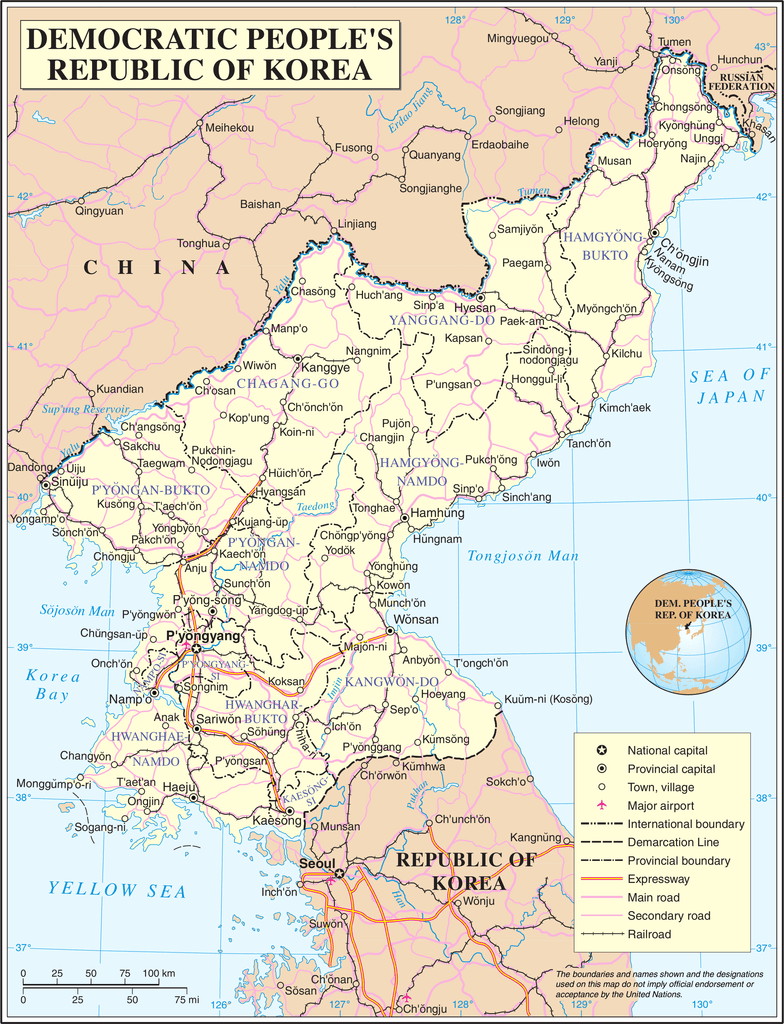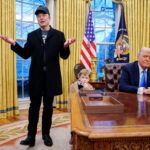A roadmap for the day after the Trump-Kim summit
By Martin B. Malin, Hui Zhang | April 17, 2018

President Trump surprised almost everyone—probably not the least Kim Jong-un—when he agreed to meet the North Korean leader at the end of May (now maybe early June). By accepting Kim’s invitation, President Trump overturned decades of conventional wisdom on how to separate North Korea from its nuclear and other WMD programs. If Trump and Kim meet—as of now this is still a big “if,” although North Korea has now confirmed its willingness to meet directly—the summit could be an important ice breaker and open up a chance to resolve the North Korean nuclear crisis and bring peace to the Korean peninsula. But success, however remote it may seem, will require new thinking and entail major risks. It will also require a plan.
Lots of naysayers, no strategy. It is not yet clear if the Trump administration has a strategy for negotiating with North Korea. Since the announcement of a possible meeting, much public commentary has focused on the improbability of North Korea ever giving up its nuclear weapons and on the apparent lack of preparedness inside the US administration. There are good reasons to be skeptical about a possible breakthrough. North Korea has spared no effort to develop its nuclear arsenal and missiles. Kim will not give up his arsenal before he is convinced his regime’s security is guaranteed. It is not clear he can be convinced.
What is clear is that US and North Korean objectives in any conceivable negotiation are at present completely incompatible. Denuclearization is an obvious US goal, but not the only one. The United States should be also seeking the removal of North Korea’s chemical and biological weapons, an end to its missile threat, and the North’s proliferation of WMD technology to others, among other issues (not the least of which are the treatment of the North Korean people). In the near term, as negotiations proceed, a key goal is ending North Korean provocations and reducing the risk of escalation to all-out war, while maintaining close coordination with US allies in the region. North Korea seeks its own survival, acceptance as a nuclear-armed state, political recognition, and an end to the economic and military pressure it currently endures. It also seeks to decouple the United States from its allies in Northeast Asia, as a means of reducing the security threats it faces.
Given the absence of meaningful negotiating space, the continuing chorus of naysayers predicting a diplomatic fiasco and worse is understandable. The only chance of progress will be if one side or the other re-evaluates its basic goals. This could happen in the course of negotiations, depending on how issues are framed and sequenced. Since defusing and ultimately resolving the crisis with North Korea will very likely take a massive diplomatic effort that would unfold over years, it is not inconceivable that a transformation of North Korea’s perceptions of its goals could take place.
But with few exceptions, there has been almost no US thinking about a negotiating strategy. Incoming national security advisor John Bolton has recently suggested bombing North Korea. Even the most thoughtful analysts have focused almost exclusively on maintaining coercive leverage in the course of negotiations.
Putting the horse before the cart. Let’s assume there will be negotiations with North Korea. Whatever strategy the United States adopts, one element should be clear from the outset—though it is unpalatable to contemplate. If North Korean denuclearization is ever to occur (a much bigger “if” than the initial meeting), it will need to be preceded by, rather than rewarded with, a peace treaty and normalization of relations with North Korea.
The United States must come to terms with the possibility that it may need to make peace with North Korea, and take significant steps toward full normalization before Kim Jong-un would ever implement a complete, verifiable, irreversible dismantlement of his nuclear arsenal. Why? Because it is reasonable to assume that Kim believes that without a nuclear deterrent, he would suffer the same fate as Saddam Hussein or Muammar Gaddafi. Nuclear weapons are at present his best insurance policy against the overthrow of his regime. The purpose of negotiations would be to convince him that other forms of insurance—peace, normalization, security guarantees—are preferable.
Since President Trump does not appear to be concerned with details, it is possible he could seek a breakthrough by agreeing in principle to make peace in exchange for a North Korean disarmament process while leaving the arrangements to be worked out by the diplomats. It is worth considering how the United States and its allies could manage such a process while keeping their alliance intact.
One possible approach to negotiations would unfold as follows:
In the first stage, Pyongyang would agree to freeze nuclear and missile testing, including the development of its missile capabilities. Pyongyang would submit a declaration of the location and operating history of all relevant facilities for fissile material production. It would need to submit parallel declarations for biological and chemical weapons production. North Korea would end plutonium and highly enriched uranium (HEU) production and disable its relevant production facilities, including its 5 megawatt-electric (Mwe) reactor, radiochemical laboratory, and enrichment facilities. The fissile material cutoff and disablement must be verified. North Korea would also agree to place the new 30 MWe experimental light-water reactor under proper international safeguards once it becomes operational. Verification of the dismantlement of chemical and biological weapons facilities would also be agreed upon and initiated. Pyongyang would agree refrain from provocative military actions during the negotiating process and cease the export of technologies, materials, and delivery systems related to weapons of mass destruction.
For its part, Washington would affirm its commitment to security assurances for Pyongyang, formally declaring its respect for Pyongyang’s sovereignty, commitment not to seek regime change, and lack of intent to attack or invade during the period negotiations are underway. Specifically, the United States would agree to freeze those aspects of -U.S.-South Korea military exercises that are most threatening, begin discussions on economic assistance to North Korea, and launch negotiations with South Korea and North Korea toward a trilateral peace treaty. Washington, Seoul, and Pyongyang would each accept liaison offices. The United States would agree to work within the UN Security Council to relax sanctions on North Korean coal exports and lift the cap on oil imports.
In the second stage, North Korea would dismantle all of its plutonium and HEU production facilities as a step toward a long-term decommissioning program. North Korea would sign and ratify the Comprehensive Test Ban Treaty and would sign, ratify, and implement the Chemical Weapons Convention and the Biological Weapons Convention. A special commission would need to be formed to verify North Korea’s disarmament in regard to biological weapons and weapon facilities. North Korea would agree to and initiate a phased, monitored withdrawal of artillery targeting Seoul, and to participate in a working group on human rights.
To reciprocate Pyongyang’s cooperation in this stage, the United States and others would provide further security and economic benefits through a further relaxation of UN and other sanctions, replace U.S. liaison offices with an embassy, establish full diplomatic relations, and agree on other steps toward political and economic normalization.As a condition of full diplomatic relations with Washington, Pyongyang would agree to cease its development of medium and long-range missiles permanently.
As mentioned above, the key to denuclearizing North Korea is the timing of normalization. North Korea will not allow its complete nuclear disarmament before receiving tangible security assurances, in particular, normalized relations with Washington.
In the third stage, Pyongyang would move to dismantle, under international supervision, its nuclear weapons and all facilities associated with the weaponization program. North Korea would surrender all its plutonium and HEU, return to the Nuclear Non-Proliferation Treaty, place all of its facilities under International Atomic Energy Agency safeguards, and implement the Additional Protocol. Eventually, if they chose to, the two Koreas could pursue a gradual integration toward reunification.
Opponents of pursuing peace in advance of denuclearization will argue that North Korea’s incentives to make good on its commitments after normalization will disappear. But the political and economic measures the United States would take are more easily reversed than are the physical dismantlement steps demanded of North Korea. The dangers for North Korea associated with reneging on its final steps will be enormous, and, if the process breaks down as a result of North Korean intransigence and results in a new crisis, the military balance will be much less favorable to North Korea than is the case today, while the credibility of US military threats in the face of a recalcitrant, double-crossing North Korea would be as great or greater than is the case today.
Alternatives? The sequence proposed here would require extensive diplomatic machinery to implement—numerous negotiating rounds, working groups, shuttle diplomacy, the choreographed involvement of China, Russia, Japan, and South Korea, action by the UN Security Council, and verification by both special and existing international bodies. The process would take years, cost millions of dollars to transact, and billions to implement, and it would entail high risks for all sides. It remains to be seen whether the Trump administration has either the capacity or desire to forge such a pathway.
But consider the alternatives. One option would be redoubling the campaign of “maximum pressure,” attempting to ratchet up further economic isolation to coerce further North Korean capitulation. Although the recent sanctions on North Korea have received impressive international support, the United States will find it increasingly hard to sustain tough sanctions in the absence of the promise of a negotiated settlement, especially as the threat of a trade war with China escalates. Nor have even the most punishing sanctions deterred or noticeably impeded North Korea’s nuclear progress or missile development. Indeed, Kim Jong-un’s desire to consolidate and cash in diplomatically on his country’s technical progress was probably as powerful a motive for his pursuing negotiations as was external pressure.
The United States with John Bolton in the White House could also try to step up military pressure and even consider preventive military force to set back North Korean progress and deter further provocations. But North Korea’s rapid progress on its nuclear weapon and missile programs over last two years have made what already promised to be an extremely costly military gambit even more complicated. South Korea has said it won’t support a US military strike. Japan would be a hostage to North Korean missiles, possibly unconventionally armed. US military force without allied support would do more to decouple the United States from its allies than anything Kim Jong-un could muster in the course of peace negotiations.
A third alternative is accepting a de facto nuclear North Korea and pursuing a strategy of deterrence and containment. But a deterrent strategy would not only be unstable and crisis prone, it would also would result in growing antagonism of China. A continuing threat of force also holds the danger of misperception giving rise to unintended escalation and war.
Considering the costs and risks of these alternatives, maybe the Trump administration should be thinking about the opportunities created by Trump’s summit surprise.
If Washington really cannot tolerate a nuclear North Korea, the United States must offer a path forward. The road to a nuclear-free Korean peninsula will be long and rugged and will require tough choices, but as long as the parties are embarked on that path and talking, the alternative of war will recede.
Together, we make the world safer.
The Bulletin elevates expert voices above the noise. But as an independent nonprofit organization, our operations depend on the support of readers like you. Help us continue to deliver quality journalism that holds leaders accountable. Your support of our work at any level is important. In return, we promise our coverage will be understandable, influential, vigilant, solution-oriented, and fair-minded. Together we can make a difference.
Topics: Analysis
















